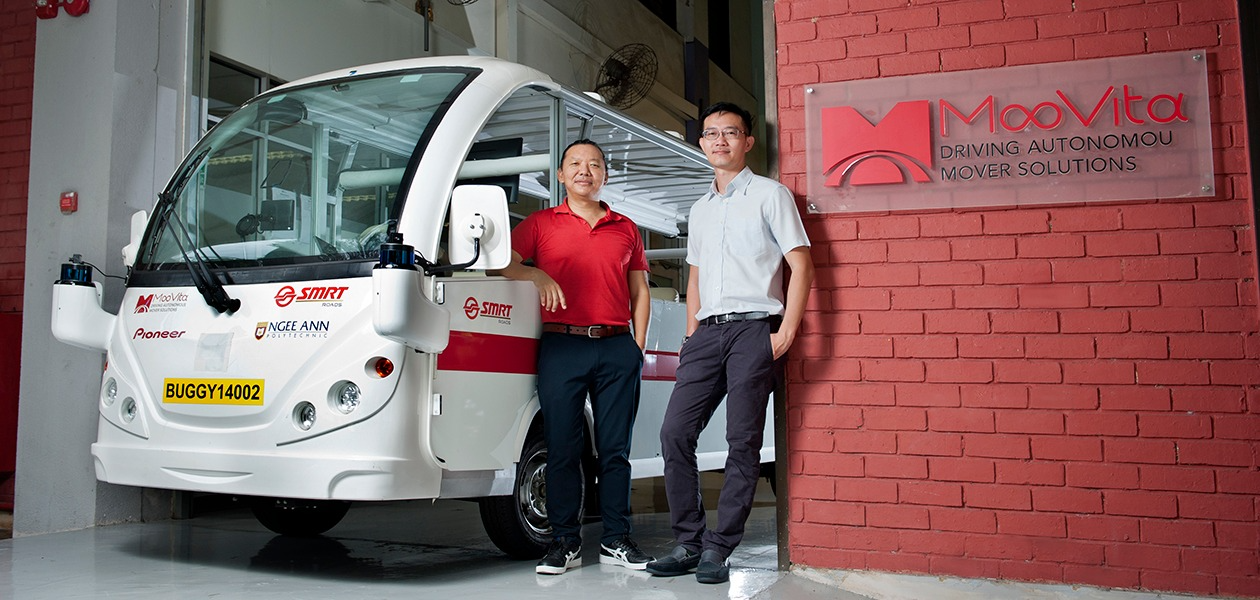MooVita and Sioux Technologies are exploring ways to improve communications between autonomous vehicles and passengers. Brought together by IPI, they aim to help Singapore become a smart nation.
A box-like vehicle revs its engine as an elderly passenger announces his destination to a large screen on the dashboard. He then settles into his seat and enjoys the journey as the self-driving car navigates itself on the roads.
In the future, owning such an autonomous vehicle (AV) may be the norm, especially for the elderly and disabled. At the forefront of AV development in Singapore is MooVita, a high-tech start-up specialising in driverless software solutions for urban environments.
Founded in 2016, the homegrown company has integrated its products on multiple vehicle platforms, including a fleet of self-driving pods for senior citizens currently in development, electric passenger buggies and passenger vehicles. It has also conducted on-demand driverless shuttle pilots in Singapore and Malaysia.
The company has its own AV line – various sizes of MooShuttle, as well as the MooAV Kit, a piece of configurable equipment that can be attached to any vehicular platform to turn it into a self-driving one.
MooVita’s goal is to expand to the larger European market, and develop a full-stack External Human-Machine Interfaces (eHMI) software that can help AVs fully assimilate with the urban environment, said Chief Operating Officer Dr Dilip Limbu.
Successful development and deployment of the technology would allow them to interact with road users in a natural manner.
Multilingual messaging for a multilingual nation
While AV public trials here have gained momentum recently, with two new sites launched at the National University of Singapore and Sentosa last year, the AVs lack the capabilities to socially interact with the public, explained Dr Limbu.
In an ageing society like Singapore, the importance of a more human touch in automated transport “cannot be downplayed”, he added, especially for vulnerable road users (VRU).
To address this, MooVita is exploring the most effective mode to convey the AV’s intent to VRUs through a multilingual-driven textual interface. This is crucial especially in a multiracial country like Singapore.
However, as the local research community is not as advanced as its European counterparts, MooVita decided to look for partners beyond local shores to speed up its plans.
Through IPI, the company learnt about the EUREKA GlobalStars-Singapore Joint Innovation Call in 2019, which aims to promote research and innovation partnerships between Singapore and several European countries. This ongoing bilateral initiative between Singapore and the EUREKA member countries gave MooVita the opportunity to seek a compatible technology partner in Europe.
In August 2019, MooVita was successfully paired with Dutch multidisciplinary high-tech solution provider Sioux Technologies, which has a strong human-machine interface (HMI) department.
Overcoming challenges to maximise potential
Sioux’s competitive edge lies in researching complex environments where humans and machines interact through clear and precise communication, such as in cleanrooms or on time-critical production lines. It is a 800 FTE powerhouse high-tech development and production company, with a presence in the Netherlands, Belgium and Germany.
“We are good at user experience development on those kinds of processes, so we are able to harness this strength into developing eHMI,” said Kelvin Ng, Managing Director of Sioux’s Singapore office. “With our experience in the European market, we can also shorten the time to market and develop the system.”
For MooVita, transferring this knowledge into autonomous transport is vital. There will be a rapidly increasing number of situations where humans and machines interact with each other, explained Dr Limbu.
MooVita is also in the midst of working with Sioux to do research on the design and production of multilingual messaging hardware.
Regular online discussions, which have become more important and prevalent during the COVID-19 period, have also helped both sides to better grasp each other's strengths and weaknesses.
“Collaboration is more efficient when people are together physically, so we are trying to overcome that through digital means in order to optimise discussions,” said Ng.
While the design and development of the eHMI is still in its infancy, MooVita and Sioux are looking to conduct closed group trials in a real-world setting with people of diverse ages and ethnicities during the final phase of this project — expected to last until the end of 2021 at least.
“The challenge now is to understand the behavioural aspects of the external environment before implementation,” said Ng. “The whole idea is to make a human-like persona so that AVs can communicate with others on the road.”
Once developed, the eHMI methods and devices “will be of keen interest” to other AV manufacturers with diverse value chains and similar objectives, said Dr Limbu.
“The market potential of AV is promising, based on the anticipated global sales of autonomous and light vehicles in the near and not-too-distant future,” he added.
According to a 2018 forecast by business information provider IHS Markit, global sales of AVs are expected to hit 33 million units annually in 2040, with European sales making up 5.5 million units.
While COVID-19 has created a “new normal of work and life” for MooVita, it is planning further ahead to catch up on missed opportunities and hoping for minimal impact on the project schedule.
“As part of Singapore’s smart mobility ecosystem and (a) pioneer in autonomous mover solutions, MooVita is committed to helping Singapore fulfil one of her Smart Nation Initiatives — Smart Urban Mobility,” said Dr Limbu.

